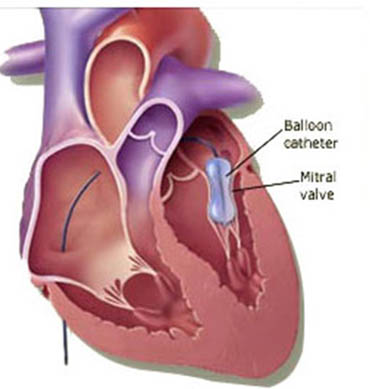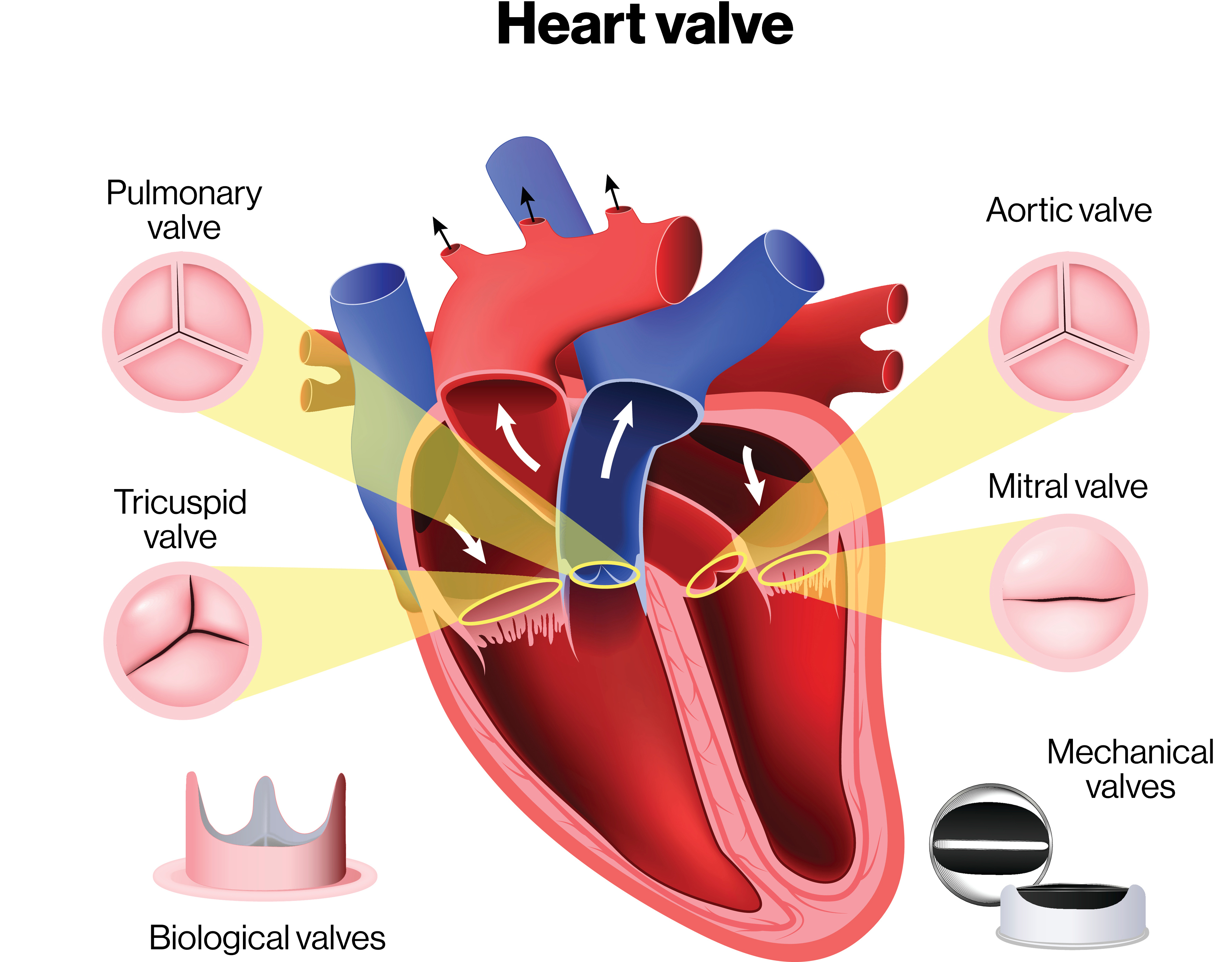DISEASES OF HEART VALVES
Valvular heart disease is characterized by damage to or a defect in one of the four heart valves: the mitral, aortic, tricuspid or pulmonary.
The mitral and tricuspid valves control the flow of blood between the atria and the ventricles (the upper and lower chambers of the heart). The pulmonary valve controls the flow of blood from the heart to the lungs, and the aortic valve governs blood flow between the heart and the aorta, and thereby the blood vessels to the rest of the body.
The mitral and aortic valves are the ones most frequently affected by valvular heart disease.
Normally functioning valves ensure that blood flows with proper force in the proper direction at the proper time. In valvular heart disease, the valves become too narrow and hardened (stenotic) to open fully, or are unable to close completely (incompetent).
A stenotic (narrowed, tight) valve forces blood to back up in the adjacent heart chamber, while an incompetent (leaky) valve allows blood to leak back into the chamber it previously exited. To compensate for poor pumping action, the heart muscle enlarges and thickens, thereby losing elasticity and efficiency. In addition, in some cases, blood pooling in the chambers of the heart has a greater tendency to clot, increasing the risk of stroke or pulmonary embolism.
The severity of valvular heart disease varies. In mild cases, there may be no symptoms, while in advanced cases, valvular heart disease may lead to congestive heart failure and other complications. Treatment depends upon the extent of the disease.
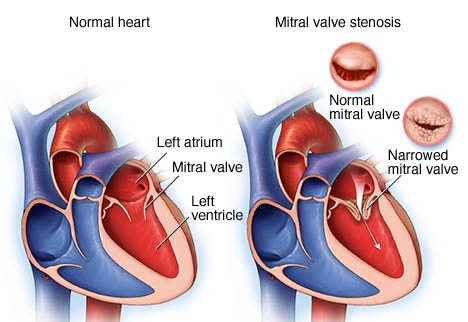
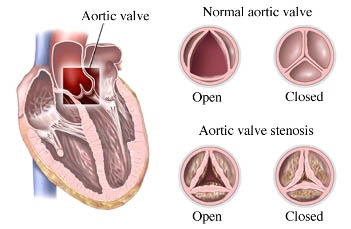
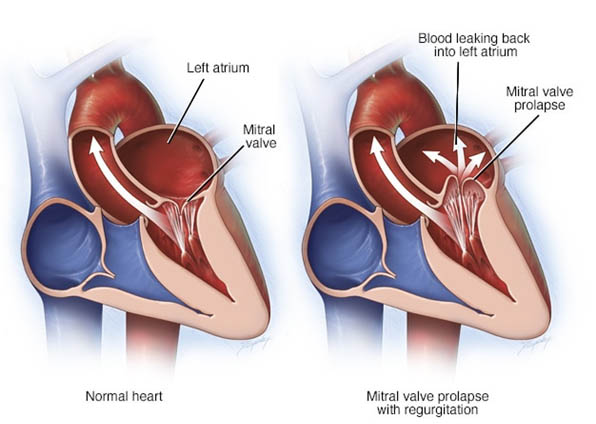
What symptoms will I get if I had valve disease?
Valve disease symptoms can occur suddenly, depending upon how quickly the disease develops. If it advances slowly, then your heart may adjust and you may not notice the onset of any symptoms easily. Additionally, the severity of the symptoms does not necessarily correlate to the severity of the valve disease. That is, you could have no symptoms at all, but have severe valve disease. Conversely, severe symptoms could arise from even a small valve leak.
Many of the symptoms are similar to those associated with congestive heart failure, such as shortness of breath and wheezing after limited physical exertion and swelling of the feet, ankles, hands or abdomen (oedema). Other symptoms include:
Palpitations, chest pain (may be mild).
Fatigue.
Dizziness or fainting (with aortic stenosis).
Fever (with bacterial endocarditis, infection over a damaged valve).
Rapid weight gain due to fluid accumulation
What causes my valve to be damaged or diseased?
There are many different types of valve disease; some types can be present at birth (congenital), while others may be acquired later in life.
Heart valve tissue may degenerate with age.
Rheumatic fever may cause valvular heart disease.
Bacterial endocarditis; an infection of the inner lining of the heart muscle and heart valves (endocardium), is a cause of valvular heart disease.
High blood pressure and atherosclerosis may damage the aortic valve.
A heart attack may damage the muscles that control the heart valves.
Other disorders such as carcinoid tumors, rheumatoid arthritis, systemic lupus erythematosus, or syphilis may damage one or more heart valves.
Methysergide, a medication used to treat migraine headaches, and some diet drugs may promote valvular heart disease.
Radiation therapy (used to treat cancer) may be associated with valvular heart disease.
Is there anything I can do to prevent valve disease?
Get prompt treatment for a sore throat that lasts longer than 48 hours, especially if accompanied by a fever. Timely administration of antibiotics may prevent the development of rheumatic fever which can cause valvular heart disease.
A heart-healthy lifestyle is also advised to reduce the risks of high blood pressure, atherosclerosis and heart attack.
Don’t smoke.
Consume no more than 5 alcoholic beverages per week.
Eat a healthy, balanced diet low in salt and fat, exercise regularly and lose weight if you are overweight.
Adhere to a prescribed treatment program for other forms of heart disease.
If you are diabetic, maintain careful control of your blood sugar.
How is heart valve disease diagnosed?
During your examination, I can identify problems in your heart valves by listening for distinctive sounds, known as heart murmurs, which indicate valvular heart disease. As part of your diagnosis, you may undergo one or more of the following tests:
An electroplsaravanangram, also called an ECG or EKG, to measure the electrical activity of the heart, regularity of heartbeats, thickening of the heart muscle (hypertrophy) and heart-muscle damage from coronary artery disease.
Stress testing, also known as treadmill tests, measure blood pressure, heart rate, ECG changes and breathing rates during exercise. During this test, the heart’s electrical activity is monitored through small metal sensors applied to your skin while you exercise on a treadmill.
Chest X-rays.
Echoplsaravanangram to evaluate heart function. During this test, sound waves bounced off the heart are recorded and translated into images. The pictures can reveal abnormal heart size, shape and movement. Echoplsaravanangraphy also can be used to calculate the ejection fraction, or volume of blood pumped out to the body when the heart contracts.
Cardiac catheterization, which is the threading of a catheter into the heart chambers to measure pressure irregularities across the valves (to detect stenosis) or to observe backflow of an injected dye on an X-ray (to detect incompetence).
What treatment is available for heart valve disease?
The following provides an overview of the treatment options for valvular heart disease:
Don’t smoke; follow prevention tips for a heart-healthy lifestyle. Avoid excessive alcohol consumption, excessive salt intake and diet pills—all of which may raise blood pressure.
If you are not very limited by the valve disease and if the valve on assessment does not appear severely diseased, I might suggest a “watch and wait” policy particularly with mild or asymptomatic cases.
A course of antibiotics is prescribed prior to surgery or dental work for those with valvular heart disease, to prevent bacterial endocarditis.
Long-term antibiotic therapy is recommended to prevent a recurrence of streptococcal infection in those who have had rheumatic fever.
Antithrombotic (clot-preventing) medications such as aspirin and or clopidogrel may be prescribed for those with valvular heart disease who have experienced unexplained transient ischemic attacks, also known as TIAs (mini-stroke).
More potent anticoagulants, such as warfarin, may be prescribed for those who have atrial fibrillation (a common complication of mitral valve disease) or who continue to experience TIAs despite initial treatment. Long-term administration of anticoagulants may be necessary following valve replacement surgery because prosthetic valves are associated with a higher risk of blood clots.
Balloon dilatation (a surgical technique involving insertion into a blood vessel of a small balloon that is led via catheter to the narrowed site and then inflated) may be done to widen a stenotic valve.
Valve surgery to repair or replace a damaged valve may be necessary.
Replacement valves may be artificial (prosthetic valves) or made from animal tissue (bioprosthetic valves). The type of replacement valve selected depends on your age, condition and the specific valve affected.
Is there any alternative to open heart surgery?
A number of per-cutaneous minimally-invasive (key hole) cardiac interventions are becoming increasingly popular and can give as good results as the open surgery. . These include:
TAVR (Trans-catheter Aortic Valve Replacement)- to treat a tightly narrowed aortic valve (Aortic Stenosis)
MITRACLIP procedure to treat a leaky Mitral Valve
Baloon Valvotomy to expand tight (stenotic) mitral or aortic valves
TAVR Procedure
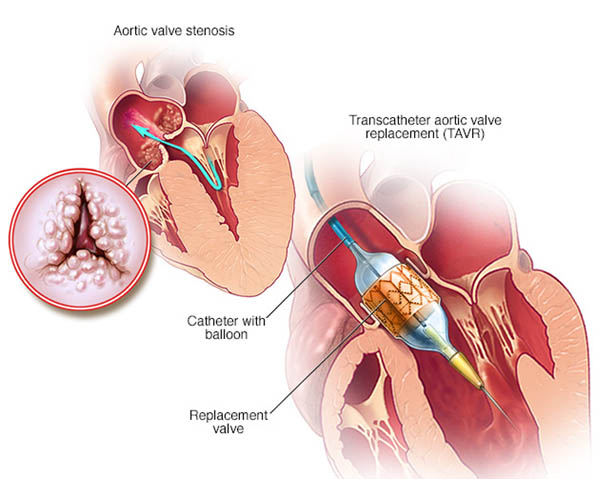
MITRACLIP” to reduce/stop leaky mitral valve
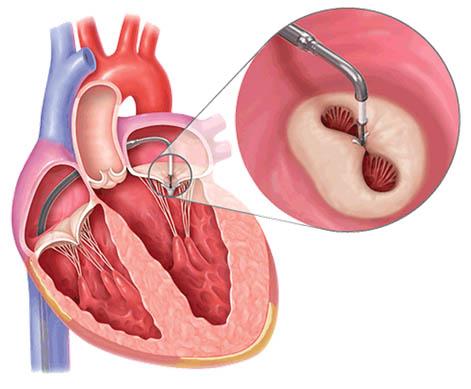
Balloon Mitral Valvuloplasty to treat mitral valve stenosis
